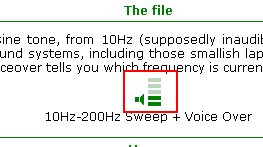Guessing what frequencies that needs to be adjusted can be a very time consuming or a trial error process. And this mostly leads you to bad mixing decisions. The appropriate method is to memorize how they feel (because deep bass sometimes needs to be felt instead of listening it with your ear) for different bass frequency levels. This is the recommended low frequency response and subwoofer sound test.

Mouse over the volume control (enclosed inside the red box in the above screenshot) and a voice of the person will say what bass frequencies are being played (it will start at 10Hz all the way up to 200Hz).
Evaluation method: Try to play some bass guitar, and then record a couple of notes. Say you start a low E string then A, D and finally the G bass string. Try to analyze what the bass fundamental frequencies affected by those strings. You can check if you get the correct results by doing a musical instrument frequency range analysis.
Exercise #4: Practice detecting subtle changes in volume levels
Importance: If you need to mix properly in your home studio, you need to spot small differences in volume levels. It is not enough to subjectively decide that the sound is indeed loud or soft; you need to train your ear to be sensitive with the most common dB (decibel) adjustments. These are the 6dB, 3dB, 1dB, 0.5dB, 0.2dB, 0.1dB. Very small differences such as 0.5dB, 0.2dB and even a 0.1dB difference are useful in mastering where you only need to do very fine EQ and level adjustments.
Evaluation method: Start with the easiest test (big differences between loud and soft); you can start with the 6dB level difference test and then gradually to a more difficult test:
a.) Blind testing a 6dB level difference
b.) 3dB level difference
c.) 1dB level difference
d.) 0.5dB level difference
e.) 0.2dB level difference
f.) 0.1dB level difference
Exercise #5: Understand the fundamental frequencies of most common musical instruments
Professional audio mixing engineers are able to spot accurately the specific frequency range of different musical instruments that needs to be adjusted. In this way, they can be able to mix and do accurate EQ adjustments if problems occur in the mix that pertains to clarity.
You might already know that both kick and bass guitars occupy the bass/subwoofer frequencies, the vocals at mid (500Hz to 3000Hz) and the hi hats at high frequencies (9000Hz above). The main problem is how these frequencies actually sound in reality.
Evaluation method: Start with a single instrument such as a simple guitar strum, and then try to analyze what could be the fundamental frequency that needs to be adjusted by simple listening (using your ear). Double check if you arrive at the correct fundamental frequency by looking at the frequency analysis response of the instrument. Practice this every day, you will notice that after weeks or months of listening you will start to be very familiar with the fundamental frequencies of different instruments by just using your ear and now becoming independent of any frequency analysis tools.
Content last updated on July 5, 2012








No responses yet